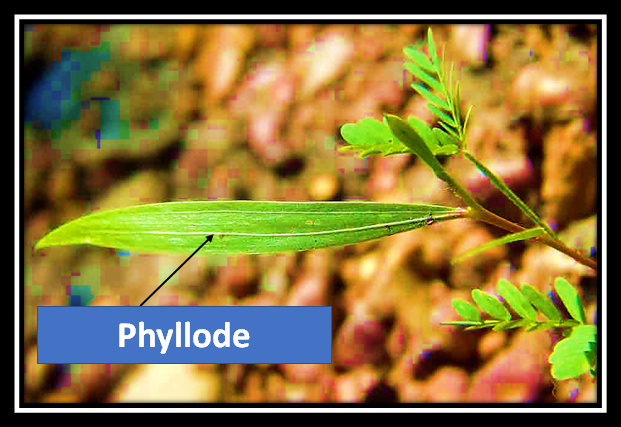
A modification of leaf is _____________.
(a)Phyllode
(b)Phylloclade
(c)Cladode
(d)Corm
Answer
473.7k+ views
Hint: This modification is presented in parts by the plants belonging to the genus Daviesia, in the family Fabaceae. It is defined as a flattened petiole or leaf rachis, resembling and functioning as a leaf.
Complete answer:
A modification of the leaf is phyllode. Let's begin with different modifications of leaves.
The whole leaf or part of it is often modified for performing special functions such as climbing and substrate attachment, protection against predation or climatic conditions, storage or trapping and digesting insect prey. Different leaf modifications are buds, scales, stipules, spines, phyllodes, tendrils, etc.
Now let's study in detail about phyllode.
Modified petioles of leaves stems are called ‘phyllodes.’ They appear like a leaf and also function like one. In some plants, they may become widened and flattened while the leaf itself becomes reduced or disappears altogether. Phyllode serves the purpose of a leaf. An example of a plant showing phyllode is euphoria roylena. Here the phyllode is cylindrical. Another example is opuntia where it is flattened. Such types of modifications are common in the genus Acacia and among them, especially in the Australian species.
Additional Information: The corm is also called bulbotuber. It is a vertical but short swollen underground plant stem. It performs the function of a storage organ for some plants which use it to survive winters or other adverse conditions such as summer drought and heat.
So, the correct answer is, ‘Phyllode.’
Note: -Cladodes and phylloclades are photosynthetic shoots. These are flattened and are usually considered to be modified branches.
-Phylloclades show nodes on them from where the leaves and branches may emerge while cladodes exhibit internodes.
-A corm may have one or more internodes with at least one growing point. This growing point is covered with protective leaves modified into skins or tunics.

Complete answer:
A modification of the leaf is phyllode. Let's begin with different modifications of leaves.
The whole leaf or part of it is often modified for performing special functions such as climbing and substrate attachment, protection against predation or climatic conditions, storage or trapping and digesting insect prey. Different leaf modifications are buds, scales, stipules, spines, phyllodes, tendrils, etc.
Now let's study in detail about phyllode.
Modified petioles of leaves stems are called ‘phyllodes.’ They appear like a leaf and also function like one. In some plants, they may become widened and flattened while the leaf itself becomes reduced or disappears altogether. Phyllode serves the purpose of a leaf. An example of a plant showing phyllode is euphoria roylena. Here the phyllode is cylindrical. Another example is opuntia where it is flattened. Such types of modifications are common in the genus Acacia and among them, especially in the Australian species.
Additional Information: The corm is also called bulbotuber. It is a vertical but short swollen underground plant stem. It performs the function of a storage organ for some plants which use it to survive winters or other adverse conditions such as summer drought and heat.
So, the correct answer is, ‘Phyllode.’
Note: -Cladodes and phylloclades are photosynthetic shoots. These are flattened and are usually considered to be modified branches.
-Phylloclades show nodes on them from where the leaves and branches may emerge while cladodes exhibit internodes.
-A corm may have one or more internodes with at least one growing point. This growing point is covered with protective leaves modified into skins or tunics.

Recently Updated Pages
Can anyone list 10 advantages and disadvantages of friction

What are the Components of Financial System?

How do you arrange NH4 + BF3 H2O C2H2 in increasing class 11 chemistry CBSE

Is H mCT and q mCT the same thing If so which is more class 11 chemistry CBSE

What are the possible quantum number for the last outermost class 11 chemistry CBSE

Is C2 paramagnetic or diamagnetic class 11 chemistry CBSE

Trending doubts
Which is not a source of freshwater 1 Glaciers and class 11 chemistry CBSE

10 examples of friction in our daily life

The correct order of melting point of 14th group elements class 11 chemistry CBSE

Difference Between Prokaryotic Cells and Eukaryotic Cells

One Metric ton is equal to kg A 10000 B 1000 C 100 class 11 physics CBSE

What is the specific heat capacity of ice water and class 11 physics CBSE




